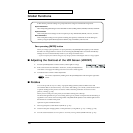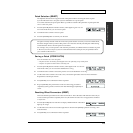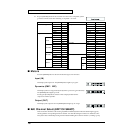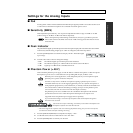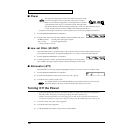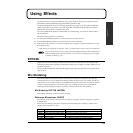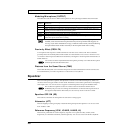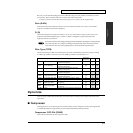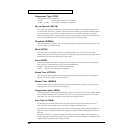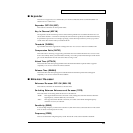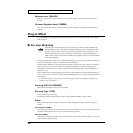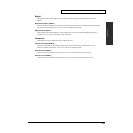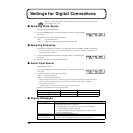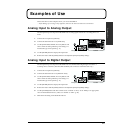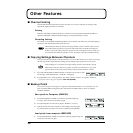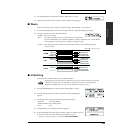
22
Using Effects
Compressor Type (TYPE)
This chooses the type of compressor.
“SOLID”: Semiconductor compressor characteristics
“TUBE1”...”TUBE4”: Vacuum-tube compressor characteristics
Key In Channel (KEY IN)
The compressor operates when the input level of the channel specified here exceeds the threshold. You
can choose either channel 1 or channel 2. Normally, the same channel is specified, but a different channel
may be specified for special uses. For example, when there is a microphone input and a background
music input, setting the microphone channel as the key-in for the background-music channel reduces the
volume of the background music when the microphone picks up someone speaking.
Threshold (THRESH)
When the input level exceeds this value, the output is lowered or suppressed according to the ratio. You
can set a value from -24.0 dB to 0.0 dB.
Ratio (RATIO)
This is the ratio for suppressing sound that exceeds the threshold. You can set a value from 1.00 to
infinity. When infinity is selected, the output level won’t get any louder even if the input level gets louder
than the threshold. This is the same effect as using a limiter.
Knee (KNEE)
This setting determines whether the change in the relationship between the input level and the output
level is abrupt or gradual when the input crosses the Threshold level.
“HARD”: Immediate change before and after the threshold
“SOFT”: Sloping change centering on the threshold
Attack Time (ATTACK)
This sets the time after the input signal exceeds the threshold until the compressor effect is completely
applied. You can set a value from 0.0 ms to 800.0 ms.
Release Time (RELEAS)
This sets the time after the input signal falls below the threshold until the compressor effect disappears
completely. You can set a value from 0 ms to 8,000 ms.
Compression Level (LEVEL)
This sets the output level after passing through the compressor. You can set a value from -24 dB to +24 dB
(from -24.0 dB to +6.0 dB in case Auto Gain is “ON”). If you are compressing the signal to even out the
loud points, you may want to boost the overall output level using this control.
Auto Gain (A-GAIN)
The dynamic range is reduced when sound passes through the compressor, but setting Auto Gain to
“ON” boosts the overall output level so as to match the original overall input level.
Specifically, this assures that the output level is loud but not distorted by creating a margin (output level
upper limit at 0 ms of attack) of 6 dB from the clipping level (0 dB) and then boosting the output level to
this point.
When the attack is set to a long time, the start of the compressor effect is delayed, and so depending on
the input signal the sound may be distorted. The Auto Gain has a margin of 6 dB to prevent spiking of the
output level due to this delay in the compressor effect.



